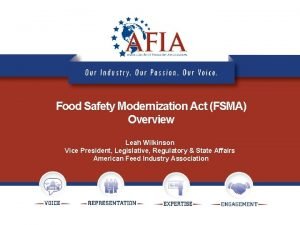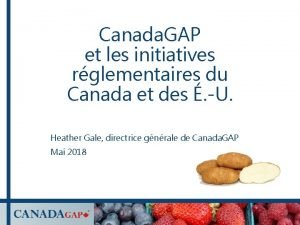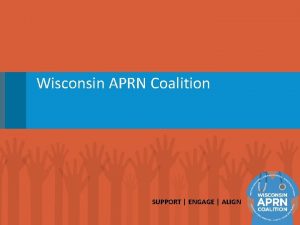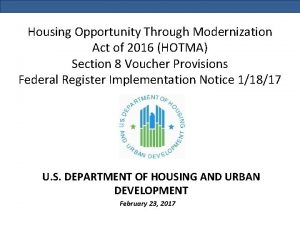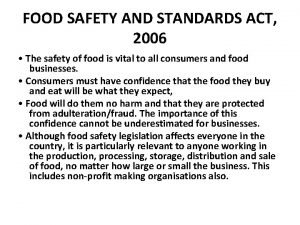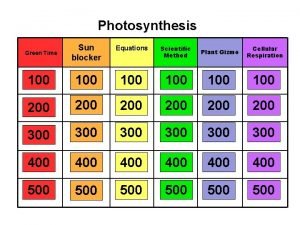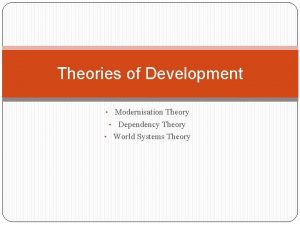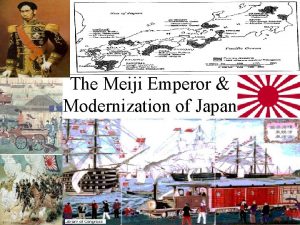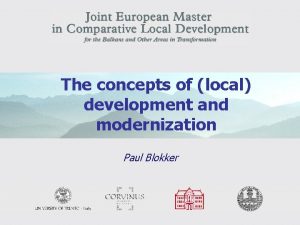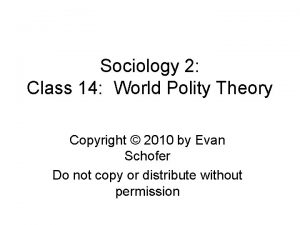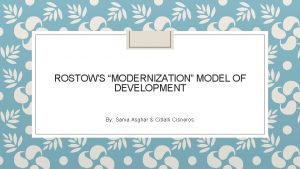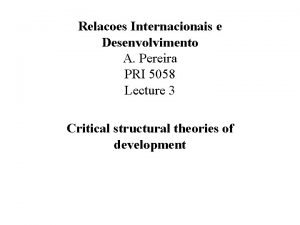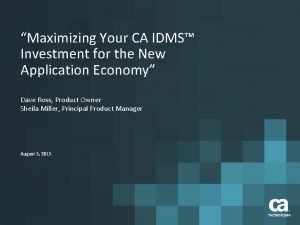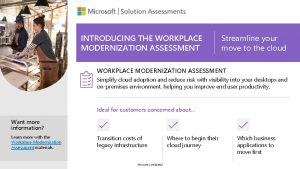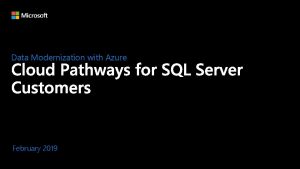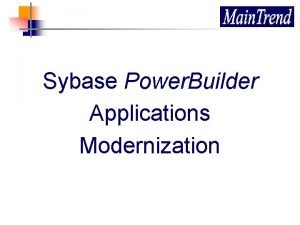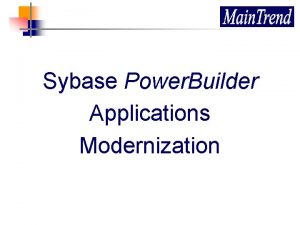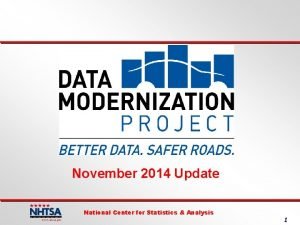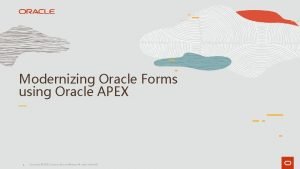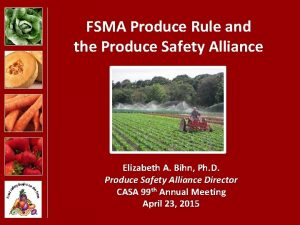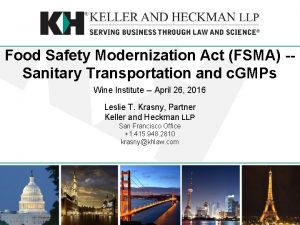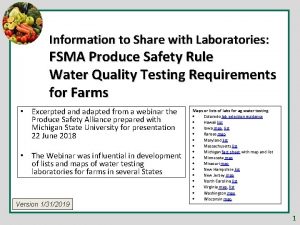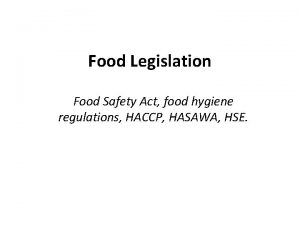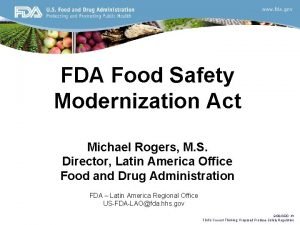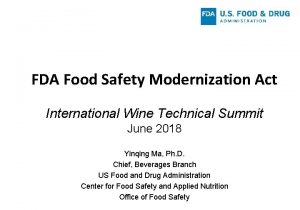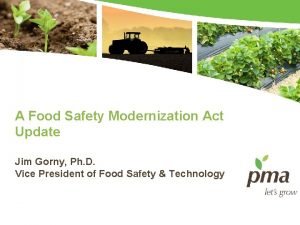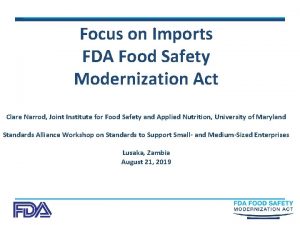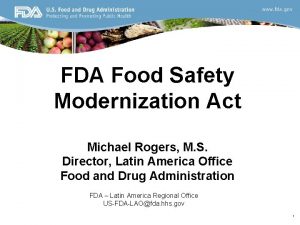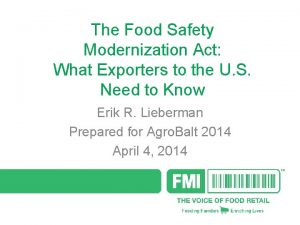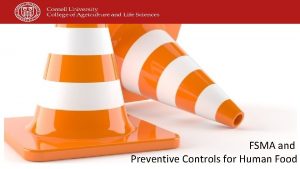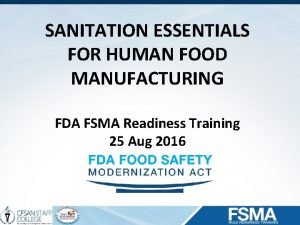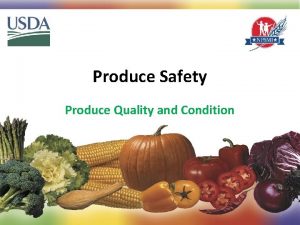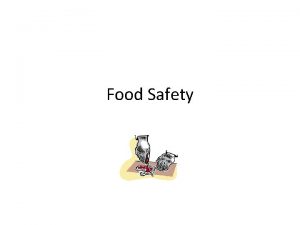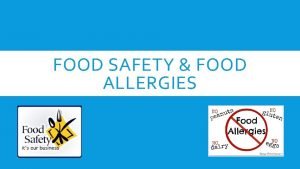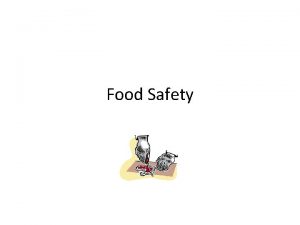Food Safety Modernization Act FSMA Produce Safety Rule





























- Slides: 29

Food Safety Modernization Act (FSMA) Produce Safety Rule

An Overview of the Food Safety Modernization Act (FSMA) Produce Safety Rule Midwest CSA Conference December 7 th, 2017

The World of Food Safety

FSMA Background • FSMA authorizes the FDA to take preventive measures to ensure the U. S. food supply is safe – thus shifting the focus away from response to contamination. • The Act was signed into law on January 4, 2011. • There are several major rules being developed in relation to FSMA that deal with all aspects of the food supply chain.


Produce Safety Rule • Establishes for the first time, science-based minimum standards for the safe growing, harvesting, packing, and holding of fruits and vegetables grown for human consumption. • It was finalized in November of 2015 and took effect in January 2016.

Definitions: Definitions matter for FSMA and the Produce Safety Rule use very specific vocabulary and while that can sometimes be confusing it is important to use their words in their intended purposes.

Produce Safety Rule and Your Farm Covered, qualified exempt or fully exempt? Covered- the action, farm or produce that is subject to the requirements of the FSMA Produce Safety Rule Qualified Exempt- exempt from much of the rule Exempt- Not required by law to comply with Produce Safety Rule

Definition: Food- food as defined in section 201(f) of the Federal Food, Drug, and Cosmetic Act and includes seeds and beans used to grow sprouts Food DOES includes (not an exhaustive list) Dietary supplements and dietary ingredients • Infant formula • Beverages (including alcoholic beverages and bottled water) • Fruits and vegetables • Fish and seafood • Dairy products and shell eggs • Raw agriculturalcommoditiesfor use as food or components of food • Canned and frozen foods • Bakery goods, snack food, and candy (including chewing gum) • Live food animals • Animal feeds and pet food

Definition: Produce is defined as “any fruit or vegetable and includes mushrooms, sprouts, peanuts, tree nuts, and herbs”. Produce DOES include Generally consumed Raw ie. Covered Produce Rarely consumed Raw Asparagus; black beans, great Northern beans, kidney beans, lima beans, navy beans, and pinto beans; garden beets (roots and tops) and sugar beets; cashews; sour cherries; chickpeas; cocoa beans; coffee beans; collards; sweet corn; cranberries; dates; dill (seeds and weed); eggplants; figs; horseradish; hazelnuts; lentils; okra; peanuts; pecans; peppermint; potatoes; pumpkins; winter squash; sweet potatoes; and water chestnuts Produce DOES NOT include Food grains that are primarily grown and processed for use as meal, flour, baked goods, cereals, and oils rather than for direct consumption. Examples include: barley, dent-or flintcorn, sorghum, oats, rice, rye, wheat, amaranth, quinoa, buckwheat, and oilseeds.

Definition: Covered vs. Not-Covered- activity or product that is subject to the requirements of the FSMA Produce Safety Rule Covered Produce- refers to the harvestable or harvested part of produce that is subject to the Produce Safety rule. This does not include produce that is for personal consumption, produce that is considered rarely consumed raw under the Produce Safety rule, and produce that is processed to adequately reduce the presence of microorganisms of public health significance. Covered Activity- Covered activity means growing, harvesting, packing, or holding covered produce on a farm. This includes manufacturing/processing of covered produce on a farm, but only to the extent that such activities are performed on raw agricultural commoditiesand only to the extent that such activities are within the meaning of farm. Actions taken to adequately reduce the presence of microorganisms are also covered activities


So how do you fit in? Confused? Let's go through this step by step

Produce Safety Rule How does it Apply to You? No Your farm is NOT covered by this rule. Yes Your farm is NOT covered by this rule. Is all your produce one of the commodities that FDA has identified as rarely consumed raw? • Section 112. 2(a)(1) • If you grow, harvest, pack, or hold more than one Yes produce commodity, you must ask this question separately for each one to determine whether that particular produce is covered by this rule. This produce is NOT covered by this rule. Does your farm grow, harvest, pack or hold produce? • Sections 112. 1 and 112. 3(c) Yes Does your farm on average (in the previous three years) have $25 k or less in annual produce sales? • Section 112. 4(a) No No

Produce Safety Rule How does it Apply to You? Is your produce only for personal on-farm consumption? • Yes Sections 112. 2(a) This produce is NOT covered by this rule. No Is your produce intended for commercial processing that adequately reduces pathogens (for Yes example, commercial processing with a “kill step”)? • Section 112. 2(b) No This produce is eligible for exemption. You must follow certain procedures. See Section 112. 2(b)(2)-(b)(6)

Produce Safety Rule How Does it Apply to You? Does your farm on average (in the previous three years) have <$500 k annualfood sales AND a majority of the food (by value) sold directly to “qualified end-users”? • • Qualified end-users are the consumer of the food or a restaurant or retail food establishment in the same state as the producing farm or not more than 275 miles from such farm. Section 112. 3(c) Your farm is eligible for exemption. Yes Which means you must comply with certain modified requirements and keep certain documentation, as per Sections 112. 6 and 112. 7 No Yes YOU ARE COVERED BY THIS RULE We use the term Qualified Exempt

Produce Safety Rule: Definition of Business Size • Very Small Business – Those farms with more than $25, 000 but no more than $250, 000 in average annual produce sales during the previous three year period. • Small Business – Those farms with more than $250, 000 but no more than $500, 000 in average annual produce sales during the previous three year period. **Produce in these definitions refers to ALL produce, not only covered produce, as well as to produce that is purchased from other farms and then re-sold. **

Compliance Dates for Produce Safety Rule Covered Activities (Except Sprouts) Size Years Date Very Small Business 4 years January 2020 Small Business 3 years January 2019 All Other Farms 2 years January 2018 For certain specified agricultural water requirements add four years to the covered activities except sprouts. (i. e. 2024, 2023, and 2022 respectively)

Compliance Dates for Qualified Exempt Farms Activity Size Years For retention of records supporting eligibility for a qualified exemption Small and very small businesse s Immediately January 2016 For modified labeling requirement Small and very small businesse s 4 years January 2020 For all other modified requirements Very small 4 years businesse s January 2020 Small businesse s January 2019 3 years Date

FSMA PSR Implementation Plan • DATCP will lead inspections, not FDA – Intends to take educational approach beginning in 2018 with On Farm Readiness Reviews – Inspections begin in 2019 on large farms – Inspections begin in 2020 for $250, 000 and up – Inspections begin in 2021 for $25, 000 and up – Starting now DATCP will still investigate outbreaks and complaints • All farms should follow federal compliance dates

Recommendations Determine how the PSR applies to your farm Develop an on-farm food safety plan Test your agricultural water Keep records!! FSMA and PSR-specific questions: - reach out to DATCP safeproduce@wi. gov - ask the TAN https: //www. fda. gov/Food/Guidance. Regulation/FSMA/u cm 459719. htm

So I may be covered by the Produce Safety or Preventive Controls Rules, What Now? • Attend a Produce Safety Alliance Training ➢ WWW. PRODUCESAFETYALLIANCE. CORNELL. EDU • Look for more information with the Local Food Safety Collaborative ➢ WWW. LOCALFOODSAFETY. ORG • Start/ continue testing your water

• National Farmers Union Foundation was awarded a grant with the FDA to provide outreach, education, and training with small local producers and processors on the Produce Safety and Preventive Controls rules. • NFUF is partnered with: o Cornell University o National Young Farmers Coalition o Deep South Food Alliance o New England Farmers Union o Maryland Department of Agriculture o Washington State Department of Agriculture

Disclaimer As both the Produce Safety Rule and Preventive Controls Rule are complex and detailed pieces of legislation it is important to note that this presentation is only intended to provide a brief overview and summary, for more thorough information please see the regulatory language published in the Federal Register or the FDA certified Produce Safety Alliance training or Food Safety Preventive Controls Alliance training.

QUESTIONS? Kirsten Slaughter, Wisconsin Farmers Union kslaughter@wisconsinfarmersunion. com 608 -514 -2031

Connect With Us! Local Food Safety Collaborative Local. Food. Safety nationalfarmersunion www. Local. Food. Safety. org

What is included in FSMA Produce Safety Rule is divided into several parts • • • Introduction to Produce Safety Worker Health, Hygiene, and Training Soil Amendments Wildlife, Domesticated Animals, and Land Use Agricultural Water Postharvest Handling and Sanitation

UPDATE September 11, 2017: Equivalent Testing Methodologies for Agricultural Water FDA has determined that the following methods are "scientifically valid" and "at least equivalent to the method of analysis in § 112. 151(a) in accuracy, precision, and sensitivity". The methods that FDA recently considered equivalent to modified m. TEC agar (EPA Method 1603) are all on the list of EPA approved methods for monitoring recreational water for generic E. coli, but some methods on the EPA list are not considered equivalent by FDA. The list of equivalent methods, as they're usually called at the labs, is: Membrane filtration methods: • m. TEC agar (EPA method 1103. 1, Standard methods 9213 D, & ASTM 5392 -9) • MI agar (EPA method 1604) • m. ENDO/NA-MUGagar (Standard methods 9222 B followed by 9222 G) • m. Coli. Blue 24 agar (Hach method 10029) Most probable number methods: • Colilert (Idexx method, using Quantitray 2000) • Colilert 18 (Idexx method, using Quantitray 2000)

Probability of Contamination Higher Risk Lower Risk Public Water Supply Treated Ground Water Surface Water Open to Environment 29
 Fsma overview
Fsma overview Fsma pcp
Fsma pcp Wisconsin aprn modernization act
Wisconsin aprn modernization act Housing opportunity through modernization act of 2016
Housing opportunity through modernization act of 2016 Financial services modernization act of 1999 definition
Financial services modernization act of 1999 definition Macbeth summary
Macbeth summary Unit 2 food food food
Unit 2 food food food Food chain food chain food chain
Food chain food chain food chain Food safety standards act 2006
Food safety standards act 2006 What is food safety
What is food safety The food that plants produce during photosynthesis is
The food that plants produce during photosynthesis is Modernization model ap human geography
Modernization model ap human geography Modernization theory vs dependency theory
Modernization theory vs dependency theory Modernization in japan
Modernization in japan Conclusion of modernization
Conclusion of modernization World polity theory example
World polity theory example 5 stages of rostow's model
5 stages of rostow's model Rrrlf library legislation
Rrrlf library legislation Modernization theory vs dependency theory
Modernization theory vs dependency theory Criticism of dependency theory
Criticism of dependency theory Modernization in japan
Modernization in japan Idms modernization
Idms modernization Workplace modernization
Workplace modernization Difference between globalization and modernization pdf
Difference between globalization and modernization pdf Data modernization azure
Data modernization azure Powerbuilder modernization
Powerbuilder modernization Powerbuilder modernization
Powerbuilder modernization Nhtsa data modernization
Nhtsa data modernization Oracle forms modernization
Oracle forms modernization Chapter 28 section 2 modernization in japan
Chapter 28 section 2 modernization in japan
